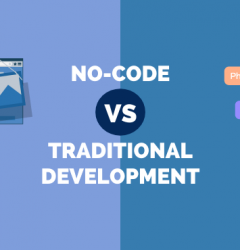
Reading Time: 3 minutes
This article was first published in TOI Reader’s Blog.
“Empowering Citizen Developers to turn their ideas into reality without writing a single line of code – that’s the magic of No-Code Low-Code.”
Are you tired of being bogged down by manual, time-consuming tasks? Enter the world of low-code and no-code automation! With low-code no-code strategies in your business, you don’t need to be a technical expert to streamline your workflow and boost productivity. Imagine being able to create custom applications with a drag-and-drop interface and unleash the full potential of your creativity and innovation.
Low-code no-code (LCNC) platforms have become a game-changer for businesses and organizations looking to automate and simplify their processes. LCNC empowers “citizen developers,” giving them the tools to create custom solutions without writing a single line of code. The result? Faster, more efficient workflows and increased productivity.
But while LCNC is changing the game regarding software development, it’s important to use these tools in a way that works with you, not against you. That’s why we’ve devised three strategies to help you get the most out of your no-code citizen development efforts. Whether you’re a seasoned pro or just getting started; these tips will help you build software that’s
efficient, effective, and truly reflective of your needs.
Top No-Code Strategies
Here are three strategies to make low-code and no-code automation work with you, not against you:
Strategy 1: Define Business Requirements Clearly
One of the primary reasons low-code and no-code automation can end up working against you is a lack of clarity on the business requirements. Before automating a process, ensure you understand what it entails, its objectives, and the desired outcome. This will ensure your tools align with the business requirements and meet your expectations.
For example, let’s say you want to automate the onboarding process of new employees. A clear definition of the process would include collecting personal information, verifying identity, and providing access to relevant systems and tools. A clear understanding of these requirements would ensure that the low-code or no-code tool you use covers all the necessary steps, reducing the risk of automating a process that is incomplete or not aligned with the business requirements.
Strategy 2: Evaluate the Feasibility of Operation
Not all processes suit automation, and some may require human intervention. Before you start automating a process, evaluate its feasibility to determine whether it fits low-code or no-code automation. Factors to consider include the complexity of the process, the data involved, and the level of customization required.
For example, let’s say you want to automate approving invoices. This process may require the approval of multiple stakeholders and involve complex calculations, making it unsuitable for low-code or no-code automation. A traditional custom development approach or a combination of low-code and custom development may be more effective.
Strategy 3: Continuously Monitor and Improve the Automated Process
Even if a process is well-suited for automation and has been automated to meet business requirements, it’s important to continuously monitor and improve the process. This ensures that the automation remains aligned with the business requirements, the technology remains relevant, and any issues or inefficiencies are identified and addressed.
For example, let’s say you have automated the process of generating reports. Continuously monitoring and improving this process would involve reviewing the reports generated to ensure they are accurate, timely, and meet the business requirements. This continuous monitoring and improvement approach would also identify and address any issues or inefficiencies, keeping the automation aligned with the business requirements.
Also Read: Tips to steer clear of Roadblocks in No-Code Joyride
Conclusion
In today’s fast-paced business world, low-code and no-code workflow automation is a game-changer that provides a quick and efficient way to develop and deploy applications. However, without proper strategy and execution, it can work against you instead of for you. That’s why it’s crucial to define your business requirements clearly, evaluate the feasibility of automation, and continuously monitor and improve automated processes.
To sum it up, LCNC automation is like a double-edged sword. If wielded correctly, it can help you achieve business success by streamlining processes and increasing efficiency. But if not handled with care, it can lead to a mismatch between technology and business objectives. So, make sure to put these three strategies into practice and watch your business soar.
As the famous quote goes, “The greatest glory in living lies in never falling, but in rising every time, we fall.” Similarly, low-code and no-code automation may have challenges, but the right strategies can help you rise to new heights of success. So, embrace the power of automation and make it work for you!
Subscribe
Login
Please login to comment
0 Comments
Oldest















